|
|
|
Sort Order |
|
|
|
Items / Page
|
|
|
|
|
|
|
| Srl | Item |
| 1 |
ID:
144327
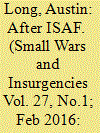

|
|
|
|
|
| Summary/Abstract |
The conclusion of the International Security Assistance Force (ISAF) mission in Afghanistan at the end of 2014 has generated substantial uncertainty about the duration and level of international commitment to Afghanistan. The fate of local allies of international forces is therefore deeply in doubt. This article is of necessity speculative rather than empirical, but it attempts to draw on the history of previous intervention in Afghanistan as well as more general patterns of local and external alliance to sketch plausible scenarios for the fate of local allies. It proceeds in four parts. First, it draws distinctions between different types of local allies in Afghanistan based on position and relationship to the Afghan state and an external actor. Second, it examines the Soviet withdrawal from Afghanistan for relevant lessons for the fate of local allies. Third, it presents a scenario based on the foregoing that assumes there will be an ongoing small but significant international military presence and accompanying resources. Fourth, it presents a scenario that assumes there will be no or minimal international military presence and accompanying resources.
|
|
|
|
|
|
|
|
|
|
|
|
|
|
|
|
| 2 |
ID:
081734
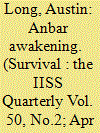

|
|
|
|
|
| Publication |
2008.
|
| Summary/Abstract |
The United States and it allies in Iraq have embraced a tribal strategy to provide security and fight al-Qaeda in Mesopotamia. This approach is not new. Saddam Hussein also sought to use tribal alliances to provide internal security. His experience, and that of the present-day Coalition, demonstrates the prospects and perils of using tribes to provide security. Tension exists between the United States' two main strategic goals of defeating al-Qaeda in Mesopotamia and building a democratic, unified Iraq. There is also the danger that Iraqi tribes will defect from the Coalition in future
|
|
|
|
|
|
|
|
|
|
|
|
|
|
|
|
| 3 |
ID:
114969
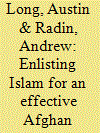

|
|
|
|
|
| Publication |
2012.
|
| Summary/Abstract |
An effective police force is central to providing security in general and is considered especially critical in counter-insurgency. The US Army's counter-insurgency doctrine embodied in Field Manual (FM) 3-24 notes that 'the primary frontline [counter-insurgent] force is often the police - not the military'. The strength and effectiveness of the police is important for waging counter-insurgency for two reasons. Firstly, the police can help directly in fighting the insurgents. In Afghanistan, police fight side by side with the military, and help provide security in many of the most dangerous areas. Secondly, building an effective and trustworthy police force is necessary for legitimising the existing government. When the police force fails to provide security (or worse, preys upon the population) the government is delegitimised. At the same time, the population's cooperation with the police is essential for effective policing. Police that are seen as outsiders simply cannot elicit the trust necessary to police a community. The importance of gaining the population's support also echoes the US military's 'population-centric' approach to counter-insurgency, as enumerated by former International Security Assistance Force (ISAF) commanders General Stanley McChrystal and General David Petraeus. Support from the population is essential to the police's role in fighting the insurgency since the population can, for example, provide the intelligence essential for identifying, locating and killing insurgents.
|
|
|
|
|
|
|
|
|
|
|
|
|
|
|
|
| 4 |
ID:
120494
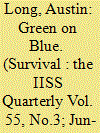

|
|
|
|
|
| Publication |
2013.
|
| Summary/Abstract |
While most counter-insurgency campaigns include a characteristic pattern of violence by members of security forces against both their fellows and their allies, the Afghan case appears to be unique.
|
|
|
|
|
|
|
|
|
|
|
|
|
|
|
|
| 5 |
ID:
136641
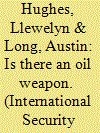

|
|
|
|
|
| Summary/Abstract |
What is the relationship between oil and coercion? For decades states have worried that their dependence on oil gives producers a potential lever of coercion. The size, integration, and sophistication of the current OIL MARKET, however, are thought to have greatly attenuated, if not eliminated, the coercive potential of oil. The best way to analyze the current global oil market is by viewing it as a series of distinct market segments, from upstream production to midstream transport to downstream refining, with the potential for coercion varying across them. Oil-producing states do not have the greatest coercive potential in the international oil market. Instead, the United States remains the dominant presence, though its dominance has shifted from production—where it resided prior to World War II—to the maritime environment. These findings are significant for scholars’ and policymakers’ understanding of the relationship between oil and coercion. More generally, they suggest that studies of the potential for states to coerce others using economic instruments should take into account differences in the structure of markets for different goods.
|
|
|
|
|
|
|
|
|
|
|
|
|
|
|
|
| 6 |
ID:
155058
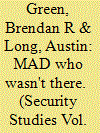

|
|
|
|
|
| Summary/Abstract |
What do nuclear weapons mean for the stability of the military balance? Mutually assured destruction (MAD) describes a stalemated balance of power where nuclear adversaries possess survivable retaliatory capabilities that ensure neither side can escape devastation in an all-out nuclear war. Moreover, the strong form of this empirical claim, which one might term “deep MAD,” is that mutual vulnerability is an inalterable and unchangeable condition. Drawing from recently declassified primary sources, we test several of deep MAD's premises and predictions on one of its foundational cases: Soviet nuclear policy during the second half of the Cold War. We find that Soviet leaders remained seriously concerned about the nuclear balance even in an allegedly deep-MAD environment where warheads numbered in the tens of thousands. Indeed, Soviet leaders were uncertain that they could indefinitely maintain a secure second strike despite strenuous efforts. The reason for these discrepancies, we argue, is that the nuclear balance is actually more malleable than commonly admitted. The possibility that MAD might one day be escaped meant that US attempts to manipulate the nuclear balance during the latter part of the Cold War could carry political weight, even while MAD was still possible.
|
|
|
|
|
|
|
|
|
|
|
|
|
|
|
|
| 7 |
ID:
134678
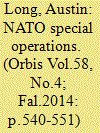

|
|
|
|
|
| Summary/Abstract |
NATO special operations forces (SOF) are at a crossroads as the NATO role in Afghanistan winds down. After more than a decade of development, NATO SOF have greatly increased their ability to operate together in the field and in headquarters. If the alliance continues to emphasize SOF development, these forces can play a major role in future NATO campaigns, particularly outside Europe. Moreover, SOF can be maintained effectively in times of austerity. Yet intelligence sharing, particularly in real time, is currently one of the major limitations on NATO SOF, creating divisions between United States and United Kingdom on one hand and much of the rest of NATO on the other. In order to make truly effective use of SOF the alliance needs to make fundamental changes to its decades old system for sharing intelligence
|
|
|
|
|
|
|
|
|
|
|
|
|
|
|
|
| 8 |
ID:
077101
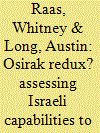

|
|
|
|
|
| Publication |
2007.
|
| Summary/Abstract |
Does Israel have the ability to conduct a military attack against Iran's nuclear facilities similar to its 1981 strike on Iraq's Osirak reactor? The Israeli Air Force has significantly upgraded its equipment since the early 1980s, but the Iranian nuclear complex is a much harder target than was the Osirak reactor. Iran has three facilities that are critical for nuclear weapons production: a uranium conversion facility, an enrichment facility, and a heavy-water production plant and associated plutonium production reactor. This article analyzes possible interactions of Israel's improved air force, including the addition of F-15I aircraft and U.S.-supplied conventional "bunker-buster" precision-guided munitions, with the Iranian target set and air defense systems. It concludes that Israel has the capability to attack Iran's nuclear infrastructure with at least as much confidence as it had in the 1981 Osirak strike. Beyond the case of Iran, this finding has implications for the use of precision-guided weapons as a counterproliferation tool. Precision-guided weapons confer the ability to reliably attack hard and deeply buried targets with conventional, rather than nuclear, weapons. Intelligence on the location of nuclear sites is thus the primary limiting factor of military counterproliferation
|
|
|
|
|
|
|
|
|
|
|
|
|
|
|
|
| 9 |
ID:
137242


|
|
|
|
|
| Summary/Abstract |
Secure second strike nuclear forces are frequently held to be easy to procure. Analysts have long argued that targeting intelligence against relocatable targets like submarine launched and land mobile ballistic missiles is difficult to obtain. However, the scholarly consensus on intelligence for counterforce operations is seriously overdrawn. Both during and after the Cold War, the United States developed substantial intelligence capabilities to track and target submarines and mobile missiles. These efforts achieved important and under-appreciated success. Second strike forces have been far more vulnerable than most analysts are willing to credit.
|
|
|
|
|
|
|
|
|
|
|
|
|
|
|
|
| 10 |
ID:
134005
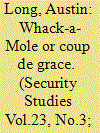

|
|
|
|
|
| Publication |
2014.
|
| Summary/Abstract |
Targeting the leadership of terrorist and insurgent groups has become a major component of US strategy since the attacks of September 11, 2001. Despite attracting modest scholarly attention, the conditions that increase or decrease the efficacy of leadership targeting remain unclear. A major limitation of current scholarly work is the lack of exploration of the internal organization of these groups and the relationship of that organization to leadership targeting effects. A close examination of leadership targeting of armed groups in Iraq and Afghanistan reveals that leadership targeting is highly effective against groups that are poorly institutionalized but has limited effects against well-institutionalized groups. This suggests that the level of resources devoted to leadership targeting should be inversely proportional to the level of institutionalization of the target.
|
|
|
|
|
|
|
|
|
|
|
|
|
|
|
|
|
|
|
|
|